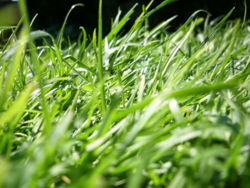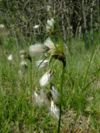Poales
<templatestyles src="Module:Message box/ambox.css"></templatestyles>
{{{1}}} |
| Poales |
|---|

|
| Scientific Classification |
|
| Families |
|
Poales is an order of monocot flowering plants recognized by some taxonomic systems (namely the Angiosperm Phylogeny Group). Other systems place these Families in the orders Bromeliales, Cyperales, Hydatellales, Juncales, Restionales and Typhales.
Fossil evidence of species from this order have been found in South America that date back 150 million years by radiometric dating.[1]
The botanists found that order of Poales has 8 families and more than 18,000 species. Among 8 families, Poaceae and Juncaceae are the predominant families.[2] Because order of Poales has lots of families and species, it can be seen easily. Most of bushes, little trees, grasses, even though some fruits are species of Poales. Fruits and crop are very beneficial species economically and agriculturally.
Anatomy
Order of Poales has 8 families. Poaceae is one of the families of Poales, and it is predominant plant. Poaceae is known as “True Grasses, because most species of Poaceae are grasses.[3] Also, Juncaceae is another predominant plant from families of Poales. Juncaceae is called “Rush Family”. Rush Family grows nearby swamp or tropical mountain which is temperate, shady, and humid area.[4]
Poaceae and Juncaceae have similar characteristic. They are both monocot flowering plant families. Monocot plant is a flowering plant with one cotyledon. Mostly it has parallel leaf veins, vascular bundles through the stem and flower.
Most monocot plants are called as grasses, if they are not trees. As monocot flowering plant, Poaceae (grass) has parallel leaf vein, fibrous roots, thin blade. The stem of Poaceae is called culm. From the node (where a leaf is attached to a stem) the leaf comes out. Because Poaceae’s root is fibrous root, it holds soil firmly and absorbs water well. Rice, wheat, corn are most dominant species of Poaceae.
Juncaceae (rush family) has almost same characteristics that those of Poaceae. It has fibrous root. Rush Family’s leaves are evergreen, and they developed well from the stems. Among family of Juncaceae, Juncus is the type genus. Juncus’ leaves are thin, flat, and do not have much hair. Also, they are cylindrical leaves.[4]
Reproduction
Most families and species of Poales are flowering plants, so they use the flowers for reproduction. The flowers are small, and most of them are easy to reproduce by wind pollinated.[1] Dandelion is a good example of wind pollinated plants. Dandelion’s seeds are light, so they can be spread easily by wind. While some species are using wind pollinated for reproduction, some species are using insect pollinated for reproduction.
The flowers of Poaceae are different from normal flowers. The small spikelets are composd of spikes. Each spikelet has more than one flower. Most of spikelets are hermaphroditic (possessing both male and female reproductive organs together). The fruit of Poaceae (true grasses) are commonly harvested from the cereal crops (rice, wheat, corn, etc).
The picture from left side will help to know what lemma, palea, glumes and spikelet are. The glumes are covering the spikelets, and they protect the spikelets. The lemma is another bract for the spikelets. The lemma is enclosed in the glumes. The palea is the cover for stigma and stamen. The lemma is the external bract, and the palea is the internal bract in the glumes.[3]
Some of Juncaceae are hermaphroditic (possessing both male and female reproductive organs together), while some of Juncaceae are dioecious (possessing male and female reproductive organs individually). The shape of flower is whirl. The stigmas and stamen are placed above in middle of the sepals.[4]
Ecology
Families and species of Poales show beautiful scenery. Most of plants from outside are families and species of Poales. Not only gives beautiful scenery to see, but also order of Poales is very beneficial plants.[1] Since the ancient time, some species of Poales were very useful to human. Some grasses could be eaten, such as, rice, wheat, and corn. Also, a pineapple was one of the fruits consumed as food. Still many people are consumed those for food.
Crops and Fruits
Poaceae is predominant family of Poales, also, it is important family of Poales for commercial use. Bromeliaceae is one of family of Poales. It is useful family of Poales with Poaceae. Poaceae produces crops, so it is mostly used flowering plants for economy. Also, Poaceae is wide spread in the world, and there are lots of species. Therefore, Poaceae is used in many areas. It is consumed by human and animals for food production. Or it is used for building something a nest shelter by the animals.
Rice, wheat, and corn are species of Poaceae. They are used for human food production. They provide protein, which is needed for humans to live. Most eastern part of Asia and South America consume rice a lot. Europe consumes wheat barely. Corn is popular food production in the world.[3] Right now, many people are enjoying rice, wheat, and corn. Poaceae is used a lot with another reason. Some species of Poaceae are great for food, while some species of Poaceae are decorating plants for beauty. (Juncaceae is used for the materials for decoration as Poaceae does.)
The pineapple is one of species of Bromeliaceae. It is used for food production as well as rice, wheat, and corn.[5]
Because Poaceae and Bromeliaceae are used a lot in many areas, they are very beneficial flowering plants economically and agriculturally.
Gallery
Pineapple
(Ananas comosus)
Subtaxa: BromeliaceaeRestio
(Restio tetraphyllus)
Family: RestionaceaeSparganium
(Sparganium erectum)
Family: SparganiaceaeXyris
(Xyris complanata)
Family: XyridaceaeMeadow Foxtail
(Alopecurus pratensis)
Family: PoaceaeCyperus
(Cyperus polystachyos)
Family: CyperaceaeEriocaulon
(Eriocaulon decangulare)
Family: Eriocaulaceae
References
- Order Poales The Succulent Plant Page










